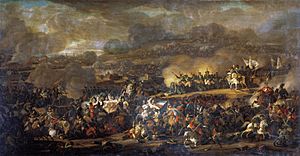Battle of Leipzig facts for kids
Quick facts for kids Battle of Leipzig |
|||||||
|---|---|---|---|---|---|---|---|
| Part of the War of the Sixth Coalition | |||||||
 The Battle of Leipzig by Vladimir Moshkov (1815) |
|||||||
|
|||||||
| Belligerents | |||||||
|
|||||||
| Commanders and leaders | |||||||
Józef Antoni Poniatowski † |
|
||||||
| Strength | |||||||
| 195,000 700 guns |
430,000 1,500 guns |
||||||
| Casualties and losses | |||||||
| 38,000 dead or wounded 20,000 captured |
54,000 dead or wounded | ||||||
The Battle of Leipzig, also known as the Battle of the Nations, was a huge fight that took place from October 16 to 19, 1813. It was fought near the city of Leipzig in Saxony, which is now part of Germany. This battle was a major event during the Napoleonic Wars, specifically as part of the War of the Sixth Coalition.
On one side was the French Emperor Napoleon I and his army. On the other side was a large group of armies from several countries, called the Coalition. These included Russia, Austria, Prussia, and Sweden. Napoleon's army had been weakened after a difficult invasion of Russia and other ongoing wars. He was outnumbered in this battle, but he decided to attack anyway. During the battle, some of his allies even switched sides to join the Coalition. This led to a big defeat for Napoleon.
The Battle of Leipzig was one of the largest battles in history before World War I. About 600,000 soldiers were involved, and it included the biggest cavalry charge ever seen. After this important battle, and a later defense of Paris in 1814, Napoleon was sent away to the island of Elba.
Contents
What Was the War of the Sixth Coalition?
The Battle of Leipzig was part of a bigger conflict called the War of the Sixth Coalition. A "coalition" is a group of countries that team up for a common goal. In this case, several European nations joined forces against Napoleon's French Empire. They wanted to stop Napoleon's control over Europe and bring peace back to the continent.
Napoleon had been very successful in many battles. He had conquered or controlled many parts of Europe. But after his army suffered greatly during the French invasion of Russia in 1812, other countries saw a chance to fight back. This led to the formation of the Sixth Coalition.
Who Fought in the Battle?
The battle involved a huge number of soldiers from many different countries.
Napoleon's Forces
Napoleon's army was made up of soldiers from France and its allies. These included:
- The French Empire
- The Grand Duchy of Warsaw (part of Poland)
- The Kingdom of Italy
- The Kingdom of Naples
- The Kingdom of Saxony (though Saxony later switched sides)
Napoleon himself led his army. He was a brilliant military leader, but even he faced a tough challenge here.
The Coalition Forces
The Coalition had a much larger army, made up of soldiers from:
- The Russian Empire
- The Austrian Empire
- Prussia
- Sweden
These armies were led by several important commanders, including Prince of Schwarzenberg for Austria, Crown Prince Charles John for Sweden, and Gebhard von Blücher for Prussia.
Why Was Leipzig So Important?
The Battle of Leipzig was a turning point in the Napoleonic Wars. Here's why:
- Huge Scale: It was one of the biggest battles in history, with hundreds of thousands of soldiers fighting. This showed the massive scale of the conflict.
- Napoleon's Defeat: It was a major defeat for Napoleon. His army was badly beaten and forced to retreat. This weakened his power and control over Europe.
- Allies Switched Sides: During the battle, the Saxon army, which was allied with Napoleon, switched sides to join the Coalition. This was a big blow to Napoleon and showed how his support was crumbling.
- End of French Dominance: The victory for the Coalition meant that Napoleon's control over Germany and Central Europe was largely over. It paved the way for the end of the Napoleonic Wars and Napoleon's first removal from power.
What Happened After the Battle?
After the Battle of Leipzig, Napoleon's forces continued to retreat. The Coalition armies followed them into France. In 1814, the Coalition captured Paris, the capital of France. This led to Napoleon giving up his throne and being sent to the island of Elba. This was not the very end of Napoleon's story, but it was a huge step towards it.
Images for kids
-
Poniatowski's Last Charge at Leipzig, by Richard Caton Woodville
-
French soldiers in skirmish with Bashkirs and Cossacks
-
Jahrhunderthalle in Breslau (modern Wrocław in Poland), also completed in 1913
See also
 In Spanish: Batalla de Leipzig para niños
In Spanish: Batalla de Leipzig para niños














